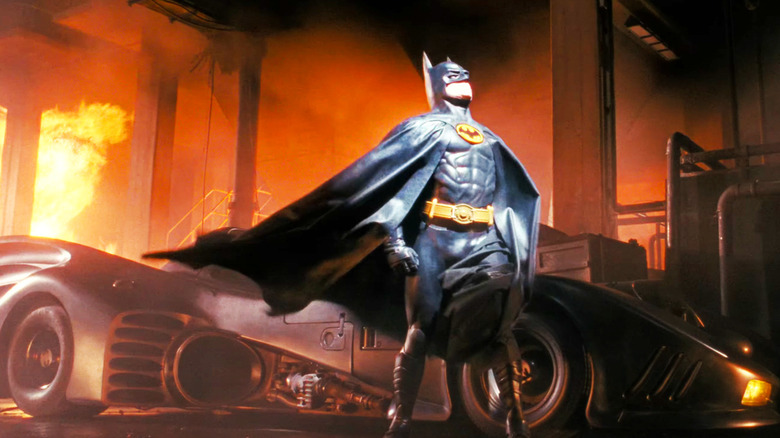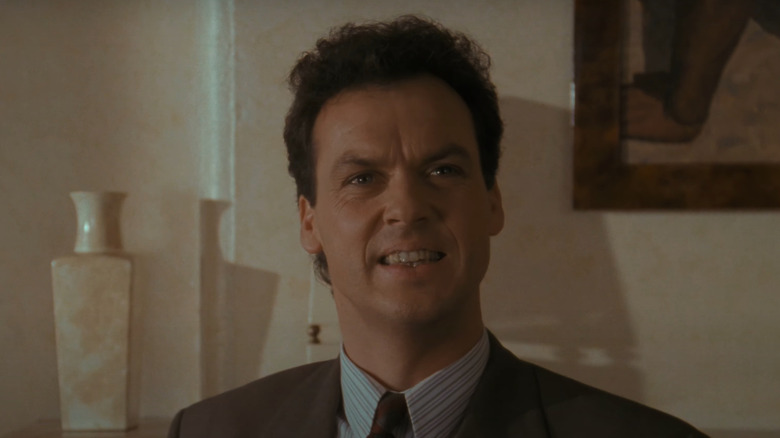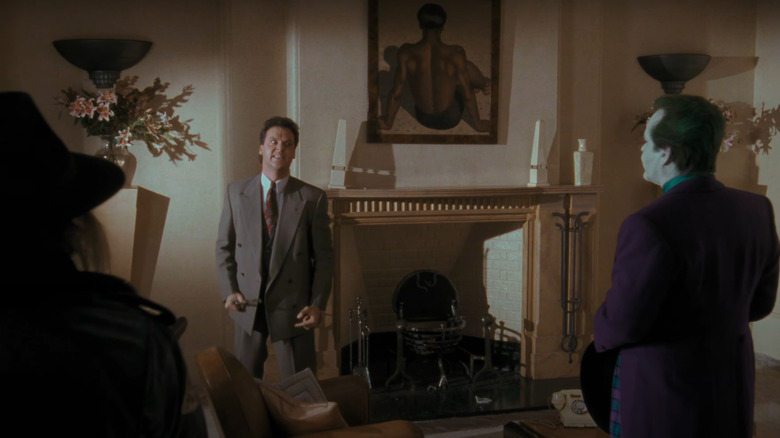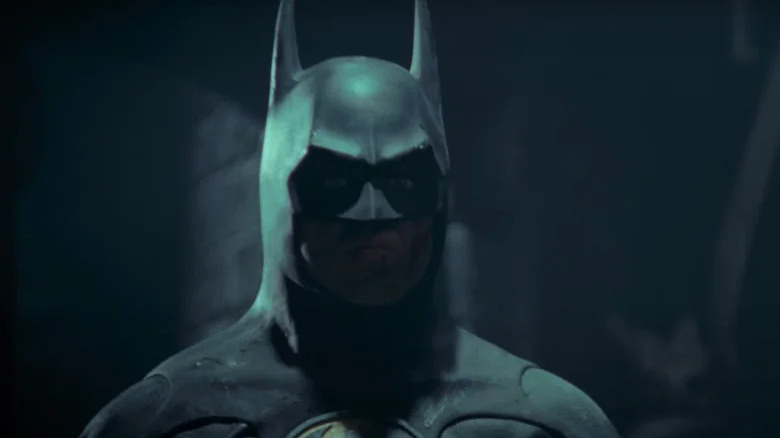Michael Keaton Was The Mastermind Behind Batman's 'Let's Get Nuts' Scene
The most memorable line in 1989's "Batman" is undoubtedly Michael Keaton's delivery of "I'm Batman." Growled in the opening moments as Batman dangles a thug off a Gotham high-rise, it's become as legendary a moment as any in the Dark Knight's cinematic saga. Since then, Batman movies have provided a steady stream of memorable quotes, from Christian Bale's snarling, "Swear to me" in "Batman Begins" to Robert Pattinson's emo Batman announcing "I'm Vengeance" in "The Batman."
But Tim Burton's "Batman" is notable for the sheer amount of quotable lines it packed into its 126 minutes. Alongside, "I'm Batman," which Keaton revived for his return as the Dark Knight in "The Flash" trailer, there's the moment Jack Nicholson's Joker famously wonders out loud about his nemesis' gadgets, "Where does he get those wonderful toys?" In fact, screenwriter Sam Hamm gave The Joker plenty of delectable lines, including his frequent use of the phrase, "Have you ever danced with the Devil in the pale moonlight?" and "This town needs an enema!" Joker even quotes lines from his own movie, mimicking Jack Palance's Carl Grissom when he informs henchman Bob (Tracey Walter) that he's his, "number one guy."
Not to be outdone, Keaton gets his share of quotable dialogue, even while playing the comparatively laconic Batman/Bruce Wayne. And perhaps the best of the lot is when he shatters that reserved demeanor after The Joker breaks into Vicki Vale's (Kim Bassinger) apartment and Keaton challenges Nicholson's villain with a truly unhinged reading of the line "You wanna get nuts? C'mon! Let's get nuts!" And if you know anything about Michael Keaton's comedy background or his often erratic energy, you might not be surprised to learn that this very moment came from the mind of "Mr. Mom" himself.
Bruce Wayne was the key
As most fans know, Tim Burton's "Batman" was seminal due to its unapologetically dark take on the central character. Borrowing from Frank Miller's decidedly gritty graphic novel "The Dark Knight Returns," Burton set out to make a film that would re-establish the Caped Crusader as a truly mysterious figure in the collective public consciousness — one who operates in the shadows of Anton Furst's decaying Gotham, designed to look as if, "hell erupted through the pavement and kept on going."
But what's not necessarily as well-known is that Michael Keaton was completely aligned with Burton's grim vision of the Dark Knight. The "Birdman" actor has spoken about finding the key to his performance in Bruce Wayne, not Batman. Keaton, who broke through in the early-'80s with family-friendly comedies such as "Mr. Mom" and "Night Shift," had proven he had dramatic chops with 1988's "Clean And Sober." But with Batman, he would push that further, displaying a talent for tasteful restraint by portraying Bruce Wayne as a brooding, taciturn loner while conveying a genuine sense of instability just below the surface.
As Keaton told In The Envelope: The Actor's Podcast, "I know the name of the movie is 'Batman' and it's hugely iconic and very cool and culturally iconic [...] [But] from a character perspective it's about Bruce Wayne. Who's that guy? What kind of person does that?" In Keaton's view, the kind of person who dresses up as a Bat was seriously psychologically unstable, which added to the darkness that was so central to his and Burton's vision. Further proof of the Oscar nominees' commitment to that vision came once Joel Schumacher took over the Batman saga and planned to lighten things up with 1995's "Batman Forever," prompting Keaton to quickly walk away from Batman.
'Let's get nuts!'
Throughout his two-movie run as Batman, Keaton knew Burton's take on Batman was a gamble, but he committed to that gamble by making changes to the scripts for both "Batman" and "Batman Returns." The actor played up the brooding loner angle by cutting more than half of his own dialogue from "Batman Returns," and he'd also punched up scenes from "Batman," including one where Vicki Vale visits Wayne Manor and, at Keaton's behest, the two sit at opposite ends of an extended table before Wayne says, "I don't think I've ever been in this room before."
For the scene where Joker descends upon Vale's apartment, only to find Wayne along with her, Keaton suggested another change. He recounted the shoot in Les Daniels' "Batman: the complete history", explaining how, "Part of Bruce Wayne and Batman was a little crazy, but you hadn't seen it because I decided to play it very contained." Up until that point in the film, Keaton's hero had only confronted Joker as his superhero alter ego. Suddenly, he was caught off-guard, facing the homicidal Jack Napier without any of his body armor or, "wonderful toys."
For Keaton, this was the perfect opportunity to display some of Bruce Wayne's repressed rage and mental imbalance, which had attracted him to the role in the first place. The actor continued, "At that point I needed to show another color. I wanted to show you that, with all that flamboyance around me, if need be, I could come up to it. So I actually kind of rewrote that scene." The rewrite involved a startling outburst from Wayne, who suddenly matches the manic energy of Nicholson's Clown Prince of Crime when he smashes a vase and explodes with the line "You wanna get nuts? Let's get nuts!"
Keaton made a good scene better
The scene in Vicki Vale's apartment is one of the most interesting in "Batman." There's so much going on in terms of plot development, emotion, and performance, and Keaton's changes simply add to the richness. In the original script, Bruce Wayne brings his utility belt to Vale's apartment intending to reveal himself as Batman. As the scene was written, Wayne was supposed to charge The Joker before being knocked down by one of his goons.
But in the scene that was shot, not only do we get a monologue from Wayne which reveals he's familiar with Joker's background as mobster Jack Napier, Wayne actually learns Joker is the one who killed his parents, after Nicholson delivers the "Have you ever danced with the Devil in the pale moonlight?" line. That's all before Keaton's changes, which, as the actor put it, involved Bruce Wayne, "using a kind of psychological ploy," where it seems as if he's given in to his anger. Once Joker shoots him, it's revealed that Wayne hid a metal tray under his shirt which stopped the bullet and allowed him to escape.
As Les Daniels noted, the scene has "layers of irony and introspection," but Keaton undoubtedly added so much by giving us a brief glimpse at what lies beneath Bruce Wayne's mask. And the fact it was all a distraction ploy also emphasizes his character's cunning, adding further layers to his portrayal and the scene itself. It all ties back to how seriously Keaton took his role and the depth he ascribed to the character, which is remarkable considering "Batman" was the first of its kind in terms of bringing real emotional and thematic depth to a comic book movie. Just another reason why Michael Keaton is the best Batman.



